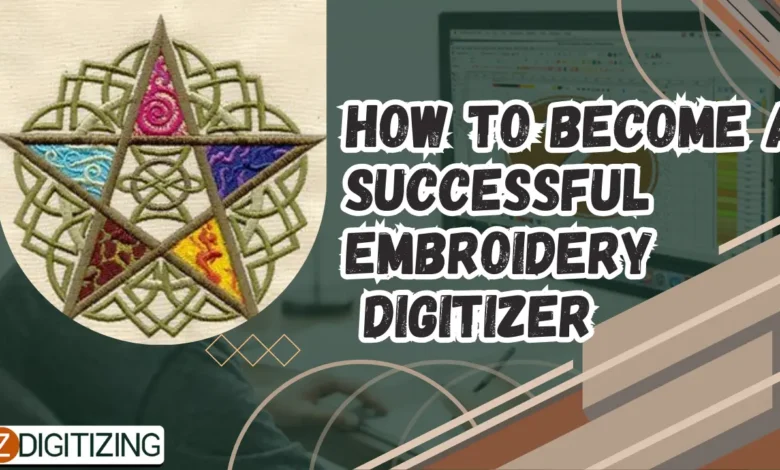
Are you interested in becoming a proficient embroidery digitizer? As an embroidery machine owner, mastering the art of embroidery digitizing can open up exciting opportunities to create custom designs and bring your creative vision to life. In this comprehensive guide, tailored for embroidery enthusiasts like yourself, we’ll explore the essential steps and skills required to become a successful embroidery digitizer. Additionally, we’ll address frequently asked questions (FAQs) related to embroidery digitizing and provide insights into partnering with digitizing companies for optimal results. Let’s embark on your journey to mastering embroidery digitizing!
Understanding the Role of Embroidery Digitizing
Embroidery digitizing is the process of converting artwork or images into digital embroidery files that can be stitched by embroidery machines. As an embroidery digitizer, your role is to translate creative designs into stitch data, taking into account factors such as stitch types, density, and sequencing to achieve the desired embroidery result.
Essential Steps to Become a Successful Embroidery Digitizer
1. Acquire Knowledge and Skills:
- Start by gaining a thorough understanding of embroidery digitizing principles, including stitch types, digitizing software, and design optimization techniques. Explore online tutorials, courses, and resources to build your knowledge and skills.
2. Invest in Digitizing Software:
- Invest in professional digitizing software that offers advanced features and capabilities for creating high-quality embroidery designs. Familiarize yourself with the software’s interface, tools, and functionalities through practice and experimentation.
3. Practice Regularly:
- Practice digitizing a variety of designs, ranging from simple logos to intricate artwork, to hone your skills and techniques. Experiment with different stitch types, densities, and effects to understand their impact on the final embroidery result.
4. Understand Fabric and Thread Properties:
- Familiarize yourself with different types of fabric and thread properties and their impact on embroidery digitizing. Learn how to adjust stitch settings and parameters to accommodate different fabric textures, weights, and stretchiness.
5. Stay Updated and Innovative:
- Keep abreast of industry trends, technological advancements, and innovative digitizing techniques through professional forums, workshops, and networking events. Embrace creativity and innovation in your digitizing approach to stay ahead in the field.
Skills Required for Embroidery Digitizing Success
1. Attention to Detail:
- Precision and attention to detail are paramount in embroidery digitizing to ensure accurate design replication and stitching results.
2. Problem-Solving Abilities:
- Develop strong problem-solving skills to troubleshoot digitizing challenges, such as stitch distortions, thread breaks, or color inconsistencies.
3. Creativity and Artistry:
- Cultivate creativity and artistry in your digitizing work to transform ordinary designs into visually stunning and impactful embroidery pieces.
4. Technical Proficiency:
- Master the technical aspects of digitizing software and embroidery machines to leverage their full potential in creating custom designs.
5. Communication Skills:
- Effective communication skills are essential for collaborating with clients, understanding their design requirements, and delivering satisfactory results.
Partnering with Digitizing Companies for Success
For embroidery machine owners seeking assistance in embroidery digitizing, partnering with a reputable digitizing company can enhance the quality and efficiency of their digitized designs. Digitizing companies offer expertise, resources, and support to help you achieve professional-quality results tailored to your specific project requirements. Whether you’re digitizing your own designs or seeking custom digitized designs, a trusted digitizing company can provide you with the guidance and assistance you need.
By collaborating with digitizing companies, you can benefit from their:
- Expertise: Digitizing companies employ skilled digitizers who have extensive experience in converting artwork into high-quality embroidery files. They understand the intricacies of digitizing various design elements and can optimize designs for superior stitching results.
- State-of-the-Art Technology: Digitizing companies utilize advanced digitizing software and cutting-edge technology to create precise and detailed embroidery designs. They stay updated with the latest software updates and enhancements to ensure efficient digitizing processes and optimal design outcomes.
- Customization Options: Digitizing companies offer customization options to accommodate unique design requirements and preferences. Whether you need adjustments to stitch density, color variations, or special effects, digitizing companies can tailor the digitized designs to meet your specifications.
- Quality Assurance: Digitizing companies implement rigorous quality assurance measures to ensure the accuracy and integrity of digitized designs. They conduct thorough quality checks and test stitchings to verify design accuracy, stitch consistency, and overall embroidery quality before delivering the final files to clients.
- Timely Delivery: Digitizing companies understand the importance of timely delivery and strive to meet project deadlines efficiently. They work closely with clients to establish clear timelines and prioritize tasks to ensure prompt delivery of digitized designs without compromising quality.
By partnering with a reputable digitizing company, embroidery machine owners can streamline the digitizing process, access professional expertise, and achieve superior embroidery results for their projects.
Conclusion
Embarking on the journey to become a successful embroidery digitizer requires dedication, perseverance, and a commitment to continuous learning and improvement. By acquiring essential knowledge and skills, mastering digitizing software, and practicing regularly, embroidery machine owners can elevate their digitizing capabilities and unlock new creative possibilities in their embroidery projects.
Additionally, partnering with digitizing companies can provide invaluable support, expertise, and resources to enhance the quality and efficiency of digitized designs. Whether you’re digitizing your own designs or seeking custom digitized designs, collaborating with a trusted digitizing company can help you achieve professional-quality results tailored to your specific project requirements.
As you continue your journey in embroidery digitizing, remember to stay curious, creative, and open to new ideas and techniques. Embrace challenges as opportunities for growth and innovation, and don’t hesitate to seek guidance and support from experienced digitizers and industry professionals.
With dedication, passion, and a commitment to excellence, you can become a successful embroidery digitizer and bring your creative vision to life with confidence and skill.
By mastering essential skills and techniques, staying updated with industry trends, and leveraging the support of digitizing companies, you can embark on a successful journey as an embroidery digitizer and bring your creative vision to life with confidence.
Frequently Asked Questions (FAQs)
Q1: Can I become an embroidery digitizer without prior experience?
Answer: While prior experience in graphic design or embroidery may be beneficial, anyone with a passion for creativity and a willingness to learn can become a successful embroidery digitizer through practice, dedication, and continuous learning.
Q2: What is the role of digitizing companies in embroidery digitizing?
Answer: Digitizing companies specialize in converting artwork or images into digital embroidery files for clients. They offer expertise, resources, and support to ensure high-quality digitized designs tailored to specific project requirements.
Q3: How can I ensure the quality of my digitized designs?
Answer: To ensure the quality of your digitized designs, conduct thorough quality checks. Including test stitching on various fabrics and adjusting stitch settings as needed. Solicit feedback from clients or peers to identify areas for improvement and refinement.




